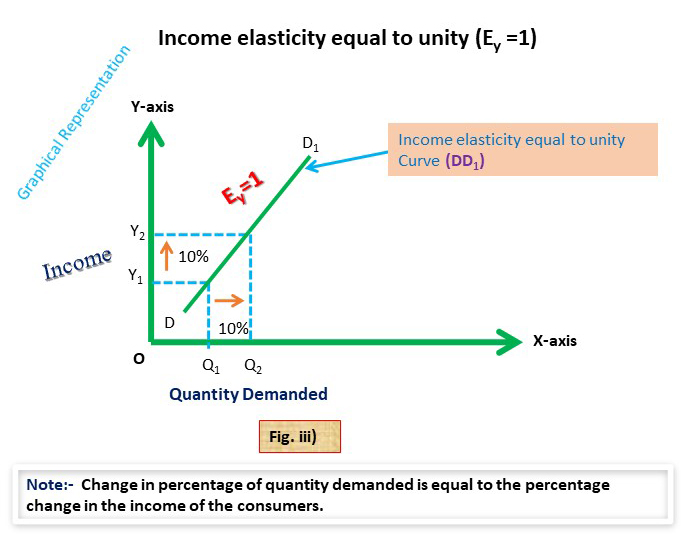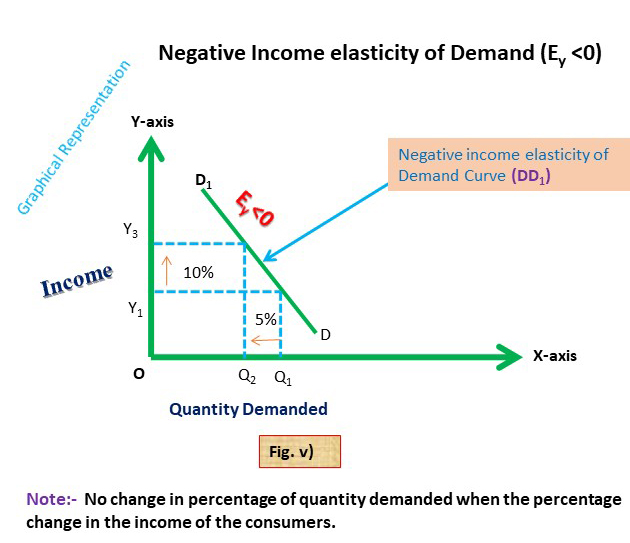Definition:
The income elasticity of demand measures how the quantity demanded changes as consumer income changes. Economists compute the income elasticity of demand as the ratio of percentage change in the demand for a commodity to the percentage change in income of the consumer. Mathematically,

Nature of income elasticity on different types of goods:
The income elasticity of demand may be positive, negative or zero depending upon the nature of a commodity.
Income elasticity for normal goods
In the case of normal goods, income elasticity is positive. Because quantity demanded and income move in the same direction i.e. demand for the commodity increase with the increase in income and vice-versa.
Income elasticity for inferior goods
In the case of inferior goods, income elasticity is negative. Because quantity demanded and income move in opposite direction i.e. demand for the commodity decrease with the increase in income and vice-versa.
Income elasticity for neutral Commodity
In the case of Neutral goods, income elasticity is equal to zero. Because quantity demanded of the commodity remains unchanged with the change in income of the consumer.
Types of Income elasticity of demand
[su_list icon=”icon: minus”]- Positive income elasticity of demand
- Negative income elasticity of demand
- Zero income elasticity of demand
Positive income elasticity of Demand (Ey>0)
If an increase in the income of the consumer leads to an increase in the quantity demanded for the commodity. It is known as positive income elasticity of demand. There is a positive relationship between the demand and income level of the consumers. Normal goods have only positive income elasticity.
Types of Positive income elasticity:
Economists classified positive income elasticity of demand into three categories.
[su_list icon=”icon: star”]- Income elasticity of demand greater than unity
- Income elasticity of demand less than unity
- Income elasticity of demand equal to unity
Income elasticity greater than unity (Ey>1)
When the percentage change in the demand for the commodity is more than the percentage change in the income of the consumer and vice-versa. It is known as income elasticity greater than unity. These types of income elasticity found in luxury goods.
Example
If 10% increase in the income of the consumer leads to 20% increase in the demand for a commodity (Car).
Income elasticity of demand =percentage change in demand/percentage change in income
=20/10=2 (which is greater than 1)
[su_highlight color=”#d50e0e”]Interpretation: When income of the consumer increase by a $1, then demand for a car increase by 2 units.[/su_highlight]
Graphically representation

In the above figure, DD1is an income elasticity curve greater than unity. When the income of the consumer increase by 10% (Y1 to Y2), the demand for commodity increase by 20% (Q1to Q2). This graph shows the percentage change in demand is more than the percentage change in income so it’s known as the graph of income elasticity greater than unity.
Income elasticity less than unity (EY<1)
When the percentage change in the demand for the commodity is less than the percentage change in the income of the consumer and vice-versa. It is known as income elasticity less than unity. These types of income elasticity found in basic goods.
Example
If 20% increase in the income of the consumer leads to 10% increase in the demand for a commodity.
Income elasticity of demand =percentage change in demand/percentage change in income
=10/20=0.5 (which is less than 1)
[su_highlight color=”#d50e0e”]Interpretation: When income of the consumer increase by a $1, then demand for a commodity increase by 0.5 units.[/su_highlight]

In the above figure, DD1is an income elasticity curve less than unity. When the income of the consumer increase by 20% (Y1 to Y2), the demand for commodity increase by 10% (Q1to Q2). This graph shows the percentage change in demand is less than the percentage change in income so it is known as the graph of income elasticity less than unity.
Income elasticity equal to unity (E=1)
When the percentage change in the demand for the commodity is equal to the percentage change in the income of the consumer and vice-versa. It is known as income elasticity equal to unity. These types of income elasticity found comfortable goods.
Example
If 10% increase in the income of the consumer leads to 10% increase in the demand for a commodity.
Income elasticity of demand =percentage change in demand/percentage change in income
=10/10=1 (equal than 1)
[su_highlight color=”#d50e0e”]Interpretation: When income of the consumer increase by a $1, then demand for a commodity increase by same number means by 1 units.[/su_highlight]

In the above figure, DD1is an income elasticity curve equal to unity. When the income of the consumer increase by 10% (Y1 to Y2), the demand for commodity increase by the same percentage i.e. 10% (Q1to Q2). This graph shows the percentage change in demand is equal to the percentage change in income so it’s known as the graph of income elasticity equal to unity.
Negative Income elasticity of demand
If an increase in the income of the consumer leads to a decline in the quantity demanded of the commodity. It is known as negative income elasticity of demand. There is a inverse relationship between the demand and income level of the consumers. Inferior goods have negative income elasticity.
Example
If 10% increase in the income of the consumer leads to 5% decline in the demand for a commodity.
Income elasticity of demand =percentage change in demand/percentage change in income
=-5/10=(-0.5) (which is less than 1)
[su_highlight color=”#d50e0e”]Interpretation: When income of the consumer increase by a $1, then demand for a commodity decline by 0.5 units.[/su_highlight]

In the above figure, DD1is a negative income elasticity curve. When the income of the consumer increase by 10% (Y1 to Y2), the demand for commodity increase by the same percentage i.e. 10% (Q1to Q2). This graph shows the percentage change in demand is equal to the percentage change in income so it reflects the graph of income elasticity equal to unity.
Zero Income elasticity of demand
If an increase in the income of the consumers has no effect on the quantity demanded of the commodity. It is known as zero income elasticity of demand. Neutral goods like salt, medicine, etc. have zero income elasticity.
Example
If 10% increase in the income of the consumer leads to 0% decaling in the demand for a commodity.
Income elasticity of demand =percentage change in demand/percentage change in income
=0/10=0
[su_highlight color=”#d50e0e”]Interpretation: When income of the consumer increase by a $1, then there is no effect on the quantity deanded for the commodity.[/su_highlight]

In the above figure, DQ1is a zero income elasticity of demand. When the income of the consumer increase by 10% (Y1 to Y2 to Y3), the demand for commodity remains constant i.e. Q1. This graph shows when the income changes, the demand for the commodity remains constant so it reflects the graph of zero income elasticity of demand.
Some Important Question Answer to Remember:
Inferior goods have negative income elasticity because its demand for commodity decrease with increase in income of consumers and vice-versa.
Positive income elasticity (income elasticity greater than unity) are found in luxury goods. Because its demand increase rapidly due to small change in demand.
Income elasticity of demand 2 reflects that when income of the consumer increase by a $1, then demand for a commodity increase by 2 units. This types of elasticity known as income elasticity greater than unity.
The income elasticity of demand measures how the quantity demanded changes as consumer income changes. Economists compute the income elasticity of demand as the ratio of percentage change in the demand for a commodity to the percentage change in income of the consumer.



